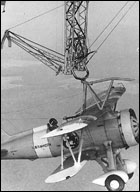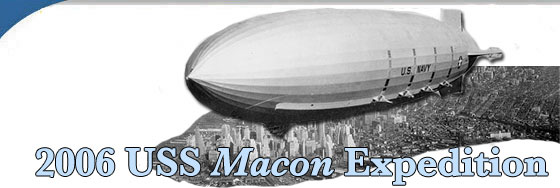|
TV Update: The National Geographic channel will air "Flying Aircraft Carrier" Feb. 9 at 9 p.m. ET featuring footage shot during this expedition by the Monterey Bay National Marine Sanctuary. This is the story of one of the biggest Zeppelins ever built: the USS Macon. Originally built in the early 1930s by German engineers, the Macon carried five Sparrowhawk planes inside her hull that could be launched and retrieved during flight.
The USS Macon, a 785-foot dirigible, was lost offshore of Point Sur on February 12, 1935 when she foundered tail first into the chilly waters of the Pacific Ocean. For decades, her underwater location remained a mystery. In 1990 and 1991, the Monterey Bay Aquarium Research Institute (MBARI) and the U.S. Navy located the Macon’s remains in deep water.
 |
|
A Sparrowhawk hangs from the trapeze of USS Macon during flight operations in 1933.
|
In 2005, a team of scientists onboard the NOAA research vessel McArthur II conducted a side scan sonar survey in the Monterey Bay National Marine Sanctuary at the wreck site of USS Macon. To learn more about the 2005 expedition to the Macon, click here.
From September 18-21, researchers from the Monterey Bay National Marine Sanctuary, Channel Islands National Marine Sanctuary, the National Marine Sanctuary Program, the Monterey Bay Aquarium Research Institute, Stanford University, and the University of New Hampshire will revisit the wreck site.
The remains of the Macon assemblage provide an opportunity to study the relatively undisturbed archaeological remnants of a unique period of aviation history. Dirigibles were an important development in the history of aviation and there are no known existing examples of these craft that can be studied on land. While there is one known example of a Curtiss Sparrowhawk in existence, it is a composite biplane built from the parts of the last two surviving F9C-2s. Future aviation historians and the public will benefit from the comprehensive documentation and management of these craft.
|



